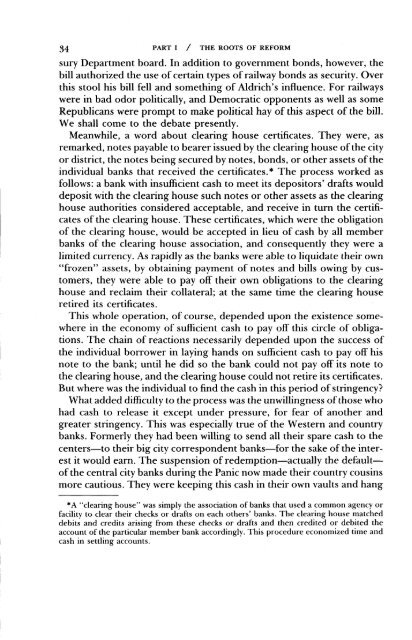You also want an ePaper? Increase the reach of your titles
YUMPU automatically turns print PDFs into web optimized ePapers that Google loves.
34 PART I / THE ROOTS OF REFORM<br />
sury Department board. In addition to government bonds,however, the<br />
bill authorized the use ofcertain types ofrailway bonds as security. Over<br />
this stool his bill fell and something of Aldrich's influence. For railways<br />
were in bad odor politically, and Democratic opponents as well as some<br />
Republicans were prompt to make political hay of this aspect of the bill.<br />
We shall come to the debate presently.<br />
Meanwhile, a word about clearing house certificates. They were, as<br />
remarked, notes payable to bearer issued by the clearing house ofthe city<br />
or district, the notes being secured by notes, bonds, or other assets ofthe<br />
individual banks that received the certificates.* The process worked as<br />
follows: a bank with insufficient cash to meet its depositors' drafts would<br />
deposit with the clearing house such notes or other assets as the clearing<br />
house authorities considered acceptable, and receive in turn the certificates<br />
of the clearing house. These certificates, which were the obligation<br />
of the clearing house, would be accepted in lieu of cash by all member<br />
banks of the clearing house association, and consequently they were a<br />
limited currency. As rapidly as the banks were able to liquidate their own<br />
"frozen" assets, by obtaining payment of notes and bills owing by customers,<br />
they were able to payoff their own obligations to the clearing<br />
house and reclaim their collateral; at the same time the clearing house<br />
retired its certificates.<br />
This whole operation, of course, depended upon the existence somewhere<br />
in the economy of sufficient cash to payoff this circle of obligations.<br />
The chain of reactions necessarily depended upon the success of<br />
the individual borrower in laying hands on sufficient cash to payoff his<br />
note to the bank; until he did so the bank could not payoff its note to<br />
the clearing house, and the clearing house could not retire its certificates.<br />
But where was the individual to find the cash in this period ofstringency?<br />
What added difficulty to the process was the unwillingness ofthose who<br />
had cash to release it except under pressure, for fear of another and<br />
greater stringency. This was especially true of the Western and country<br />
banks. Formerly they had been willing to send all their spare cash to the<br />
centers-to their big city correspondent banks-for the sake of the interest<br />
it would earn. The suspension of redemption-actually the defaultofthe<br />
central city banks during the Panicnow made their country cousins<br />
more cautious. They were keeping this cash in their own vaults and hang<br />
*A "clearing house" was simply the association of banks that used a common agency or<br />
facility to clear their checks or drafts on each others' banks. The clearing house matched<br />
debits and credits arising from these checks or drafts and then credited or debited the<br />
account of the particular member bank accordingly. This procedure economized time and<br />
cash in settling accounts.

















